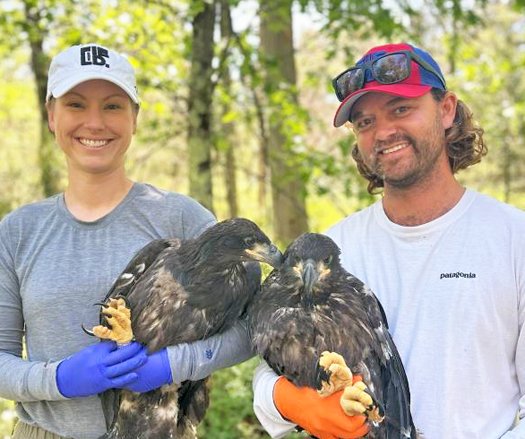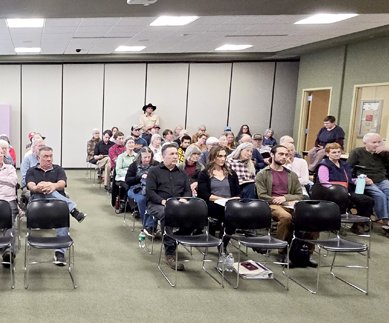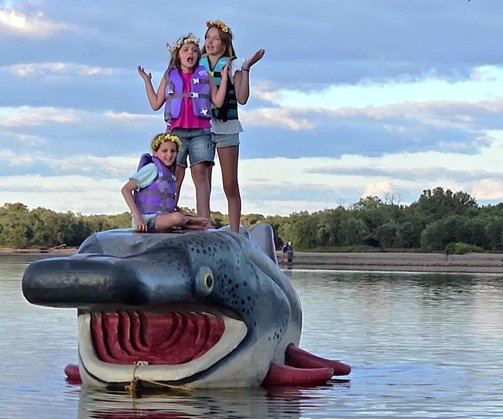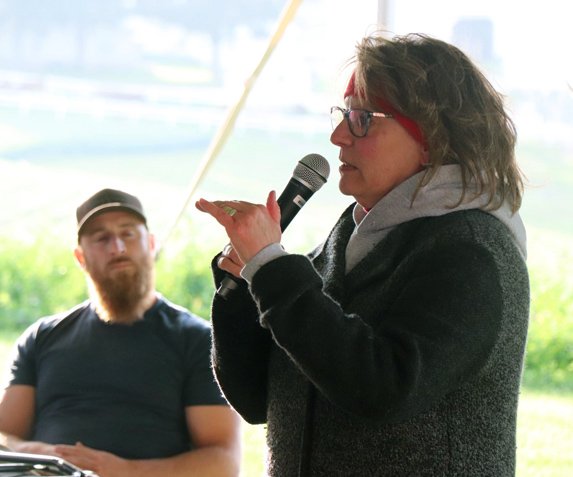The Vernon County Board of Supervisors unanimously (19-0) passed a resolution calling for “the assistance of State Senator Brad Pfaff, State Representative Tara Johnson, and Governor Tony Evers to facilitate discussions between the County's engineering firm [SEH] and the WDNR to resolve what appears to be conflicting opinions on the requirements for a complete feasibility report [for expansion of the Vernon County Landfill].”
The resolution was amended by the board after discussion to change the ask for the politicians from “supporting the expansion” to “asking for assistance to facilitate discussions with WDNR.”
That resolution came after the county received a second ‘incompleteness determination’ letter from WDNR regarding the feasibility report for the proposed expansion. Responding to the second notice, SEH hydrogeologist Melanie Niday, who has formally put forward the theory that the landfill is underlain not by karst, but rather pseudokarst, expressed surprise upon receipt of the second notice.
At the end of her written comments to the Vernon County Infrastructure Committee, she put forward the following recommendations:
“In reference to the WDNR letter and our discussion above, the County has limited options. SEH cannot guarantee that the WDNR will approve the Feasibility Study with any additional work. It is clear that the County really only have three options:
1. Withdraw the expansion project.
2. Appeal to elected officials (which we can’t address). Even with support of elected officials, we can’t change the WDNR’s process and dealing with public opposition.
3. Complete our proposed field work to address groundwater concerns in the southeast corner as planned, submit Addendum No. 2 (including more written responses to their letter), and hope for the best.”
Board discussion
Prior to taking the vote, the Board engaged in a long and probing discussion of what the options are for the county to move the project forward, and what likelihood of success they may have.
Supervisor Wade Lawler asked Landfill Manager Stacie Sanborn how much money invested in the landfill expansion comes from the tax levy?
“Most of the money used came from Landfill funds, and about $55,000 is from levy,” Sanborn responded.
“How can we pay for the expansion if we have to spend another $2 million?” another supervisor asked.
“The expansion will add 342 tons of additional airspace,” Sanborn said. “The rest of the expansion costs will be paid for by a loan, and paid back from the $23 million in tipping fees generated over the 15 years of life of the operation.”
Another supervisor asked how Sanborn could justify a budgeted $69.50/ton tipping fee when she told the Infrastructure Committee recently that the Landfill’s competitors are currently offering a $50/ton tipping fee rate?
“The way we would achieve that would be through signed contracts with municipalities and haulers,” Sanborn said.
Another supervisor asked about the recent meeting with SEH, and what the likelihood is that the county will receive approval from WDNR to expand the landfill?
“Brian Kent from SEH told me that it seems like things are going backwards,” Vernon County Administrative Coordinator Cassie Hanan said. “He said that WDNR just seems to want more and more data, and said that he can’t, in good faith, advise us to move forward. He said if we get a third notice of incompleteness, that will probably trigger an Environmental Impact Study (EIS).”
County Board chair Lorn Goede clarified that in the resolution proposed, drafted by him, Hanan, and County Clerk Jerome Pedretti, “the purpose is not to pressure politicians, but rather to enlist an intermediary to help us resolve this situation.”
Goede said that, at this point, he wants to avoid a third letter of incompleteness, and feels that the county needs a mediator to facilitate the discussion between SEH and WDNR.
“Mediation sounds good, and I’d say that before you get a reply, stop spending more money on this,” Supervisor Charlie Jacobson, a member of the Infrastructure Committee, said.
“I called Tara Johnson to give her a heads up about this resolution,” Hanan said. “She told me that she and Brad Pfaff are open to having a conversation with WDNR to inform themselves about the situation.”
Supervisor Martha Olson, also a member of the Infrastructure Committee, said that the recommendations from Melanie Niday “don’t sound very promising. I found Dennis Brault’s comments very interesting [former Vernon County Board chairman, comments submitted in writing prior to the meeting], where he said that he was assured that the second expansion of the landfill undertaken during his tenure would be the last. I understand concerns about groundwater and PFAS – just look at the Town of Campbell – what if that were to happen to us?”
“I understand that people are concerned about the potential expense of $300,000 to $400,000 if we were to get a third notice of incompleteness, and an EIS winds up being required,” Lawler said. “I agree with Charlie about not spending more money, but there are risks to stopping the expansion process as well. If we don’t expand, then we might be at the mercy of one company, where there is no guarantee of what tipping fees they’ll charge, and no guarantee of environmental protection. I think we should explore all avenues without further expense. If we’re faced with a third letter and an EIS, that will be another crossroads, but that’s not what’s in front of us today.”
Supervisor Alycann Taylor said that this issue has been very conflicting for her from the very beginning.
“I favor local control, but I think we put the cart before the horse in voting for expansion before getting approval from WDNR,” Taylor said. “I appreciate Wade’s comments – it seems like we’re very impatient now. I’ve heard the narrative that there’s a group of people that are stirring the pot – maybe that’s true, but those people are also our constituents, and I don’t like that we’re dismissing their concerns.”
Taylor said that she had two questions she would like answered:
“What impact will the agreement with the Town of Viroqua have when that becomes part of the discussion?” Taylor asked.
“We’re still negotiating, but the Town Siting Agreement will have an impact on the Plan of Operation, not on the Feasibility Study,” Sanborn responded.
“The Town Siting Committee is asking for compensation of $3/ton versus the $0.50 we pay them now,” Olson said. “That’s definitely going to impact our numbers.”
“My second question is, does the resolution before us have the support of the Infrastructure Committee?” Taylor asked.
“The Infrastructure Committee agreed to bring the matter to the Board of Supervisors, but this resolution was wordsmithed by me, Cassie and Jerry,” Goede said.
“This whole idea started as asking the politicians to mediate, but this resolution is asking them to support the expansion,” Jacobson observed. “A mediator’s job is not to take one side or another.”
Supervisor Mary Henry asked if both of the notices of incompleteness were signed by the same person from WDNR?
“Yes, both letters were signed by Bridget Kelly,” Hanan responded. “There’s a group of people that we work with at WDNR, but it’s always the same people – there haven’t been any changes.”
“Then why do things keep changing if it’s the same group of people?” Henry asked. “What is making it change?”
Supervisor Nathan Slack asked if, under the circumstances, the county would go forward with drilling the two monitoring wells approved at the last meeting.
“Will this well be useful to us in some way even if the expansion is denied?” Slack asked.
“The well to be drilled next week will address the monitorability of the expansion site, and the other eight unanswered points about karst geology and geophysics,” Sanborn responded. “The well will also be useful in a long-term care and closure situation, and our long-term care and closure funds are housed with WDNR, and amount to over $4 million in cash.”
Supervisor Mary Henry commented that “the county needs to do better with putting less into the landfill – we need composting and better recycling. I am very concerned about us sending our waste to the GFL landfill, a for-profit company facing many lawsuits. Also, PFAS is another big issue.”
Public input
The Board of Supervisors allowed public input early in the meeting in the ‘audience to visitors’ section of the agenda, but also immediately prior to taking up the resolution calling for the assistance of politicians.
“I am concerned about how vague the resolution that has been proposed is,” former landfill manager Gail Frie said. “Our municipalities are responsible for our waste forever, no matter where they send it. A few people are feeding WDNR false claims. The County Board of Supervisors operates on a committee structure, and this resolution did not come through proper channels. Whoever proposed it should have known it – this is a case of the tail wagging the dog – follow the money.”
“In a matter with such high stakes, it’s important to have input,” Viroqua resident Monica Matos said. “I’m not sure I know all that I need to know – that’s why open dialogue is so crucial – civil, two-way communication is vital with such a complex issue.”
KJ Jacobson spoke about landfill finances and the life of the site.
“The 2024 financial report for the landfill shows a $34,000 loss in recycling, and a $34,000 profit from the landfill,” Jacobson said. “This is not consistent with the numbers, and is not based on proper accrual accounting. The landfill expansion put the cart way before the horse, and is an example of fiduciary irresponsibility.”
Jacobson further observed that an air space analysis needs to be done, because she thinks that the current landfill is either close or at capacity right now.
“I call on the Board of Supervisors’wisdom to stop the expansion, and stop throwing good money after bad,” Mike Bieser said.
“Melanie Niday talks about two prior assessments conducted at the landfill site in her letter,” Dr. Kelvin Rodolfo said. “The first assessment used antiquated equipment, and the second study showed a flow of 87-feet-per-day, when typical flow of water through bedrock is 1-2 feet-per-day. Niday is in denial of karst, and her report is intellectual garbage.”
Vicki Ramsey lives in Viroqua, and has worked as an environmental educator for the last 30 years.
“I bring my students from Youth Initiative High School to the landfill because I value the work they do, and I believe the operators feel strongly about being environmental stewards,” Ramsey said. “But, the work by KJ and others speaks to the vulnerability of aquifers in karst geology, and the sensitivity of groundwater is crucial – landfill liners can leak.”
Wade Lawler said he had read Dennis Brault’s remarks, and understood that he had served as a member of the Solid Waste Committee (precursor to the Infrastructure Committee).
“In his remarks, he said that he had understood that the second expansion of the landfill would be the last,” Lawler said. “He also said that the landfill site was the ONLY site suitable for a landfill in Vernon County – just think about that. The feud with Southwest Sanitation is ongoing after they built their transfer station. I recommend beginning emergency planning for if the landfill is closed.”
Tom Lukens, a business owner in the West Fork Kickapoo watershed, said that he’d sent his written comments via e-mail prior to the meeting.
“The most important of my comments pertains to the March 11 meeting of the Infrastructure Committee where the second notice of incompleteness from WDNR was discussed,” Lukens said. “The committee asked that the second notice be discussed by the Board of Supervisors, and now we have this last-minute resolution on the amended meeting agenda. Someone stepped over the process. The board chair is in denial of karst, and the WDNR’s concern is karst. The financial situation of the landfill is precarious, and the Board of Supervisors is not getting the full picture. There are three options from WDNR, and an EIS study would cost between $300,000 and $400,000. Last year, the landfill lost $300,000 if proper accounting procedures are used. You’ve got three-quarters of a million invested in the expansion proposal so far, and this doesn’t account for the environmental liability.”
Lukens said that AnnaJo Doerr, a member of the Town of Viroqua Siting Committee, said that the county has never had a formal agreement with the town around siting and compensation before. He pointed out that now the town has legal counsel, and some of their requests will further complicate the financial viability of the landfill.
“The Town of Viroqua is asking, if the expansion goes through, for a firm end date,” Lukens pointed out.
Claire from Viroqua commented that she really appreciates AnnaJo Doerr, and said that the Board of Supervisors “really needs to look at past contention between Southwest Sanitation and the Vernon County Landfill. We need a future vision for Vernon County solid waste and recycling.”
A supervisor from Vernon County Town of Webster weighed in.
“I understand karst geology, and I was so happy when the landfill got underway because it was better than what came before,” they said. “If we lose local control, and truck our garbage to Eau Claire or Boscobel, what is the environmental cost of that? We need more Clean Sweep events, and we need to be more self-reliant.”
Dan Helgerson, mayor of Westby weighed in on the issue.
“I favor the landfill expansion. The biggest issue is the long-range control of tipping fees. The safety of our landfill is above and beyond state standards, and if we don’t expand our landfill, then people will start throwing garbage in sinkholes again, and that goes straight to the water,” Helgerson said.
“Viroqua already pays for garbage disposal,” Viroqua resident Lori Heinz said. “You are ignoring the science and the experts in favor of listening to a consultant that thinks we have pseudokarst – once we pollute our aquifers, it’s forever.”
Dwight, a Town of Genoa supervisor said, “I think it’s a good idea to keep the landfill.”
Kyle Kruizenga, a Town of Viroqua resident and sweetcorn grower weighed in on the topic.
“I live next to the landfill, and there currently is no town host agreement, just a handshake,” Kruizenga said. “When the landfill expanded in 2002/2003, there was supposed to be an end date, but that just keeps getting moved. I’m here because Lorn put two options on the table, but there were three presented by the engineering firm. He wants to put pressure on elected officials to put pressure on WDNR. I am also upset about Lorn saying, “there is no karst.” I have sinkholes on my land and there are more sinkholes nearby. My neighbor just found a new cave, and I am very disappointed to see our karst geology denied. I took off work to be here, and the proposed resolution is an abuse of your power.”
Mark Davidson is a resident of the Vernon County Town of Forest. He re-told the tale of ‘Chicken Little,’ and said the Board of Supervisors could draw their own conclusions.
Janet Jordan, a Town of Forest resident commented that “we haven’t heard what the alternatives are if the landfill is shut down,” and said “it’s time to move forward, now!”
Jim, who works for the Town of Forest in their recycling center, said that “back in the mid-‘90s, I worked with the town patrolman to clean up two spots where town residents would dump their garbage – WDNR required us to clean it up.”
Landfill Stacie Sanborn had the last word.
“The second notice of incompleteness wasn’t a surprise to us, since WDNR told us it was coming,” Sanborn said. “We’ve had lots of meetings with WDNR, and they showed us on a map where they wanted us to drill additional monitoring wells. We responded to 21 of the 30 issues in WDNR’s first notice of incompleteness, but WDNR is still concerned about karst. SEH hydrogeologist sent her comments about the second notice, and right now, we are at a bit of an impasse between SEH and WDNR.”
Sanborn said that according to Mark Peters with WDNR, the idea that landfill liners begin to fail after 30 years is not based in fact.
“Subtitle D landfills have leachate collection systems, and WDNR’s concerns don’t mean that a release [to groundwater] has or will occur,” Sanborn said. “Our landfill exceeds state and federal standards, and there is over 75-feet to the perched aquifer, and over 100-feet to the regional aquifer. Further, we wouldn’t have a perched aquifer if there was lateral flow into the regional aquifer. The leachate collection system keeps the landfill dry – we collect about 2.6 million gallons of leachate per year, and remove it.”





